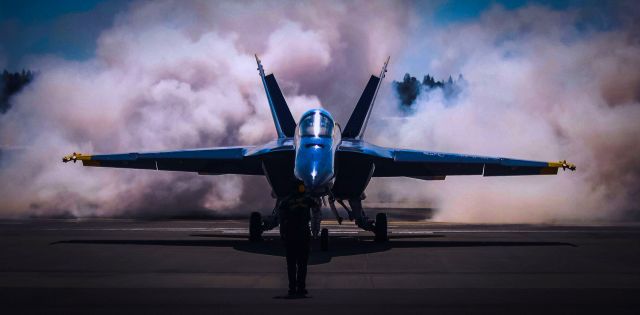모두
 |
|
McDonnell Douglas FA-18 Hornet (16-5885)
Lcdr Amanda Lee #4 Blue Angels Boeing Air Show Seattle 8-2-2024
Comments
Cool photo!
Epic!
Neat Mood with this photo....
Can someone please explain the rudder positions.
@Al Miller - This is pretty much everything about Rhino control surfaces...
Living Wing
The Super Hornet has a living wing, that is to say, the shape of the wing is constantly in motion throughout every regime of flight. Trailing edge flaps, leading edge flaps, stabs, rudders, and ailerons all move in concert to give the pilot the greatest control during particular phases of flight.
This is evident by the use of the flaps switch. The three flap positions are, Auto (Up), Half, and Full. Up auto means that the flight control system (FCS) will dynamically change the wing based on what it thinks the pilot is trying to do. However, when the flaps switch is placed in the half and full positions the FCS switches to landing mode, and all flight control inputs will be interpreted as such. Even though the flaps switch has been placed to half/full, the pilot has only changed the FCS logic, he has not actually commanded the flaps to a fixed position. There are no fixed gains (flaps positions) like there are in typical commercial aircraft. Instead, the computer adjusts the flaps position to mimic a flaps half/full position, while also giving the pilot the most stable platform it can for landing. The logic has its limits though and if the pilot exceeds 14 AoA in a landing mode (flaps half or full), the FCS may accidently depart the jet. This is obviously bad 200 ft above the ground. This switch commands the FCS to make flight control decisions and is the toggle between the tactical, and landing modes of flight.
Rudder Toe-In
The particular effect you are referencing is called rudder toe-in. At slower speeds, particularly during high angles of attack, the stabilators may not provide sufficient nose authority to crisply rotate the nose. The massive wing area of the Rhino tends to block the airflow over the stabs. To remedy this problem the Rhino's rudders will automatically bias to the inside and create a downward force, which pitches the nose upwards. While the rudder is toed-in, the pilot can still use the rudders to yaw the aircraft. The FCS selectively moves the rudder position to generate the yawing motion, even while retaining the fared-in position.
Take-off and Landing
During takeoff the rudder will remain in the toe-in position for a fixed 10 seconds after it detects weight off the wheels. This prevents the aircraft from accidentally faring the rudders (and losing nose authority) during one of the most critical phases of flight (AoA probe failures will actually cause the rudders to automatically fare, and this problem is removed by a fixed timing.) During the landing portion of flight, the rudders will also be fared in to give the aircraft more nose authority, and this is handled automatically by the FCS once the pilot commands the aircraft into landing mode by placing the flaps switch out of up auto.
Living Wing
The Super Hornet has a living wing, that is to say, the shape of the wing is constantly in motion throughout every regime of flight. Trailing edge flaps, leading edge flaps, stabs, rudders, and ailerons all move in concert to give the pilot the greatest control during particular phases of flight.
This is evident by the use of the flaps switch. The three flap positions are, Auto (Up), Half, and Full. Up auto means that the flight control system (FCS) will dynamically change the wing based on what it thinks the pilot is trying to do. However, when the flaps switch is placed in the half and full positions the FCS switches to landing mode, and all flight control inputs will be interpreted as such. Even though the flaps switch has been placed to half/full, the pilot has only changed the FCS logic, he has not actually commanded the flaps to a fixed position. There are no fixed gains (flaps positions) like there are in typical commercial aircraft. Instead, the computer adjusts the flaps position to mimic a flaps half/full position, while also giving the pilot the most stable platform it can for landing. The logic has its limits though and if the pilot exceeds 14 AoA in a landing mode (flaps half or full), the FCS may accidently depart the jet. This is obviously bad 200 ft above the ground. This switch commands the FCS to make flight control decisions and is the toggle between the tactical, and landing modes of flight.
Rudder Toe-In
The particular effect you are referencing is called rudder toe-in. At slower speeds, particularly during high angles of attack, the stabilators may not provide sufficient nose authority to crisply rotate the nose. The massive wing area of the Rhino tends to block the airflow over the stabs. To remedy this problem the Rhino's rudders will automatically bias to the inside and create a downward force, which pitches the nose upwards. While the rudder is toed-in, the pilot can still use the rudders to yaw the aircraft. The FCS selectively moves the rudder position to generate the yawing motion, even while retaining the fared-in position.
Take-off and Landing
During takeoff the rudder will remain in the toe-in position for a fixed 10 seconds after it detects weight off the wheels. This prevents the aircraft from accidentally faring the rudders (and losing nose authority) during one of the most critical phases of flight (AoA probe failures will actually cause the rudders to automatically fare, and this problem is removed by a fixed timing.) During the landing portion of flight, the rudders will also be fared in to give the aircraft more nose authority, and this is handled automatically by the FCS once the pilot commands the aircraft into landing mode by placing the flaps switch out of up auto.
Dramatic photo and thanks Darrell for an excellent 'tour' of the flight control system. It's certainly sophisticated, and that sure is a LOT of UP elevator in the picture!
|
활동 로그
1998년까지 거슬러 가는 16-5885에 대한 완전한 이력 검색을 원하십니까? 지금 구매하세요. 1시간 이내에 구하십시오.
|
| 날짜 | 항공기 | 출발지 | 행선지 | 출발 | 도착 | 비행시간 |
|---|---|---|---|---|---|---|
| No Recent History Data | ||||||
| 기본 사용자 (기본 사용자가 되는 것은 무료이고 쉽습니다!) 3 months 이력 보기. 참여 | ||||||


Please log in or register to post a comment.